New tax refund policy hits right notes


Over the past few weeks, when I went shopping at Beijing's SKP department store and the Qianmen area along the city's Central Axis, I found a growing number of foreign visitors receiving their tax refunds on the spot, after shopping in these places.
This phenomenon has certainly become more common after China rolled out in late April its new tax refund policy that allows inbound tourists to get tax refunds immediately after purchases.
Since the policy was piloted in cities such as Shanghai, Beijing, Shenzhen in Guangdong province as well as a few other places earlier, it has been well received by a large number of overseas travelers, significantly boosting consumption growth.
Previously, China's tax refund procedures for foreign visitors were processed at departure airports, which was cumbersome and resulted in some tourists giving up their tax refunds.
The new policy allows eligible international visitors to receive their tax refunds instantly, rather than having to wait in line at airports until they leave the country.
The service allows travelers to experience the benefits of tax refunds, and facilitates their use of the program for additional shopping on site, stimulating immediate consumption willingness.
Several European nations — including France and Italy — have implemented instant tax refund services on site or fast tax refunds at airports. Countries in Asia, such as Japan, South Korea and Singapore, have also optimized their tax refund processes through digital means.
When I shopped in Japan previously, I received my tax refund immediately upon purchase. It was a good shopping experience as I could instantly benefit from the policy, which further incentivized me to spend.
Now, China has enhanced the tourism shopping experience by applying the mechanism nationwide, benchmarking with mature tax refund systems overseas.
"The policy stands as an important measure taken by China to benchmark international high-standard economic and trade rules. It has become an accelerator to help stimulate inbound consumption in China," said Andrea Yue, partner of indirect tax services at professional services firm EY.
"Improving the openness of the consumption sector in China can help enhance economic resilience and showcase the attractiveness of the Chinese market," Yue said.
Last year, the number of overseas tourists who applied for tax refunds in China — and the sales revenue of related products sold — as well as the value of refunds, increased by 230 percent, 120 percent and 130 percent year-on-year, respectively, said the State Taxation Administration.
"The penetration rate of China's electronic payment systems is globally leading, providing a technological foundation for instant tax refund services. The national implementation of the policy, coupled with the 240-hour visa-free transit arrangement, is forecast to boost inbound tourism and spending on shopping," Yue said.
She added that China is expected to become the world's largest inbound tourism market this year. In such a context, comprehensively promoting the instant tax refund service can better meet the consumption demand of overseas tourists, unleash their consumption potential, and promote the growth of China's tourism economy.




































